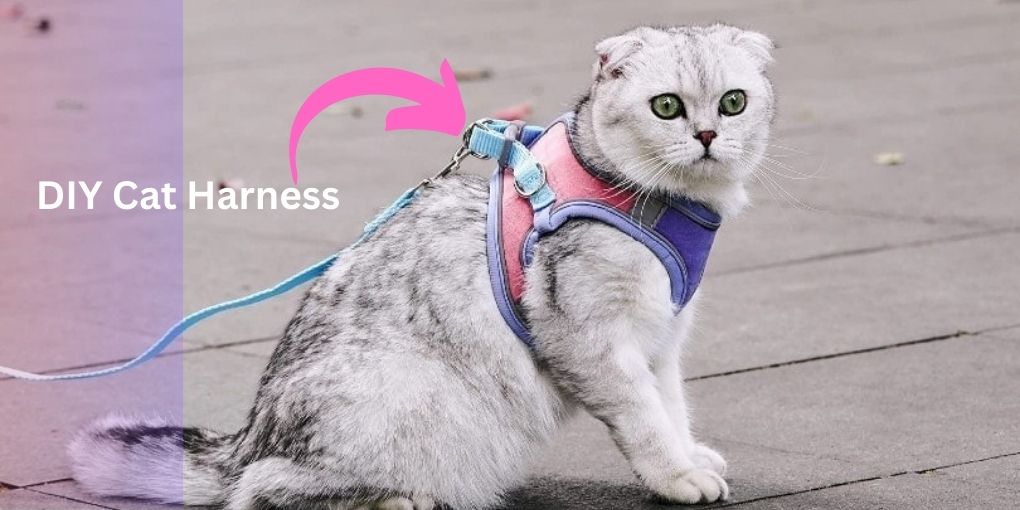
Let’s go through the steps to make your DIY cat harness with materials you can find at home or at a craft store. The whole process is definitely going to be fun, hands down!
Let’s get started with the cat harness!
Read More On: Best Escape Proof Cat Harness
Understanding the basics of a cat harness
What are the basic components of a cat harness. It includes the different types of harnesses available and their respective pros and cons.
Let’s look at the materials used in making cat harnesses and their durability.
Understanding the basics of a cat harness will help you make an informed decision when making a harness for the feline friends.
Importance of using a cat harness
If you’re a cat owner, then you’re probably familiar with the importance of using a cat harness.
It’s a great way to keep your feline friend safe and secure while giving them the freedom to explore the outdoors.
Do get to know the benefits of using a cat harness and why it’s a better option than letting your cat roam around without any protection. So, let’s dive in!
Different types of cat harnesses
There are several types of cat harnesses available on the market, each with its own unique design and features. Some of the most common types include:
H-style harness
This type of harness forms the shape of an “H” around the cat’s neck and chest, providing a secure fit and distributing pressure.
Vest harness
The vest harness wraps around the cat’s chest and fastens with a buckle or Velcro. It provides a comfortable and secure fit, especially for cats who are escape artists.
Figure-eight harness
The figure-eight harness has two loops that cross over each other and sit behind the cat’s front legs. It’s easy to put on and can provide a snug fit for cats of all sizes.
Jacket harness
The jacket harness covers the cat’s entire body, providing warmth and protection from the elements.
It’s a good option for cats who need extra support due to injury or arthritis.
Escape-proof harness
As the name suggests, this type of harness is designed to prevent cats from escaping. It often has multiple straps and buckles to ensure a secure fit.
Walking jacket
The walking jacket is a combination of a harness and a jacket. It provides a snug and secures fit while also keeping the cat warm and protected from the elements. It’s a good option for cats who like to go on outdoor adventures.
Benefits of DIY cat harnesses
Making a cat harness is not only an affordable option but also allows you to customize the harness to suit your cat’s unique needs. Here are some benefits of making your own cat harness:
Cost-effective:
Making your own cat harness is an affordable option compared to buying a store-bought one.
Customizable:
You can make a harness that fits your cat’s body shape and size perfectly.
Creative outlet:
Cat harness making projects can be a fun way to tap into your creativity and personalize your cat’s look.
Eco-friendly:
Cat harnesses can be made using recycled or upcycled materials, which is a more sustainable and eco-friendly option.
Bonding opportunity: Making a cat harness at home can be a great bonding experience between you and your cat.
What are the different materials and tools needed to make a cat harness, let’s read and learn fast!
Materials needed for DIY cat harnesses
If you’re interested in making your own cat harness, there are several materials you’ll need to gather first. Here are some of the most commonly used materials for cat harness projects:
Nylon webbing:
This is the main component of the harness, providing strength and durability.
Buckles:
You’ll need buckles to fasten the harness around your cat’s body.
D-rings:
D-rings are used to attach the leash to the harness.
Sewing thread:
You’ll need a strong, durable thread to sew the harness together.
Sewing machine or needle and thread:
Depending on your level of skill and preference, you can use a sewing machine or needle and thread to construct the harness.
Scissors:
You’ll need scissors to cut the nylon webbing to size.
Measuring tape:
You’ll need to measure your cat’s body to ensure the harness fits properly.
Steps to make a cat harness
Making your own cat harness can be a fun and rewarding project, and it can also save you some money. Here are the steps to make a simple home made cat harness:
Measure your cat
You will need to measure your cat’s neck and chest to ensure that the harness fits correctly.
Use a measuring tape and measure the circumference of their neck and chest.
Cut the webbing
Cut the webbing to the appropriate length based on your cat’s measurements.
You will need two pieces of webbing for the neck and two for the chest.
Add the hardware
Thread the webbing through the hardware, making sure to attach it to the correct piece of webbing. For the neck, use D-rings, and for the chest, use buckles.
Sew the webbing
Sew the webbing together, making sure that the hardware is secure. You can use a sewing machine or sew by hand.
Create the leash attachment
To attach a leash, you can use a swivel clip or a metal ring. You can attach it to the back of the harness.
Test the harness
Once you have finished making the harness, it’s important to test it out on your cat to make sure it fits comfortably and securely. Adjust the harness as needed.
Decorating your DIY cat harness
In this section, we’ll cover some fun ideas for decorating your handcrafted cat harness. After all, why settle for a plain harness when you can add some personality to it?
- Add patches: Sew on some cute patches or badges to showcase your cat’s favorite things or your own interests.
- Embellish with beads or rhinestones: Add some sparkle to your cat’s harness by gluing on some beads or rhinestones.
- Paint or draw on the harness: Use fabric paint or markers to add some designs or doodles to your cat’s harness.
- Attach small bells or jingle balls: Not only do they add a decorative touch, but they can also help you keep track of your cat’s whereabouts.
- Make a bow or bowtie: Using a small piece of ribbon or fabric, make a bow or bowtie and attach it to the harness.
- Use fun-colored or patterned fabric: Instead of using plain fabric, choose a bold or colorfully patterned fabric to make your hand made cat harness stand out.
- Add a name tag: Sew or glue on a small name tag to personalize your cat’s harness.
Safety precautions to consider when making a cat harness
When making a cat harness, safety should always be a top priority. Here are some precautions to consider:
Choose the right materials
Use materials that are sturdy, durable, and safe for your cat. Avoid using materials that can easily break o r cause harm to your cat.
Check for choking hazards
Make sure that there are no small or loose parts on the harness that your cat could swallow or choke on.
Proper fit
Make sure the harness is not excessively slack or tight. A harness that is too tight can restrict your cat’s breathing and movement, while a harness that is too loose can allow your cat to escape or get tangled up.
Supervision
Always supervise your cat while they are wearing the harness. This will allow you to quickly address any issues or concerns.
Test the harness
Before taking your cat outside, test the harness inside your home to make sure that it fits properly and that your cat is comfortable wearing it.
Follow these safety precautions and your cat harness is safe and comfortable for your feline friend.
Conclusion
At this point you’ve got the clear picture for making your own cat harness. Remeber to consider safety precautions when making a DIY cat harness to ensure your feline friend stays comfortable wearing it.
To take care of your cat better than ever, do follow our regular updates.
Read More:

Patricia White is a pet enthusiast. With 10 years of experience in the pet industry, she brings a wealth of knowledge and expertise to MeToPet. She is honored to be a part of the MTP team and is dedicated to sharing her passion for pets with our readers.









